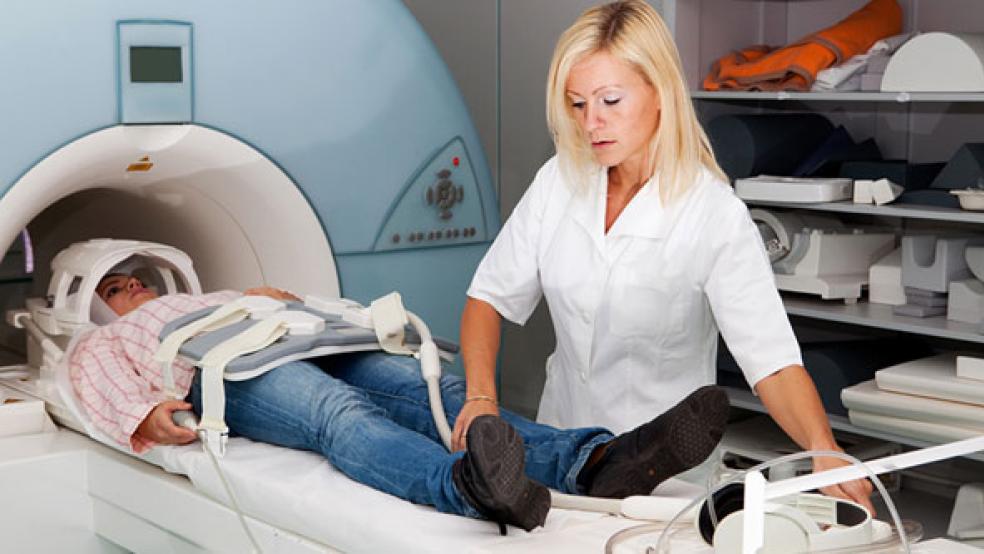Medical imaging is one of the most common and overused diagnostic techniques used today, and by far the costliest. While cancer caused by radiation from medical imaging can be a long-term concern, the more immediate worry for someone facing a new diagnosis is usually cost.
The good news is that there are at least a few tools that can help patients curb spending on medical imaging, which is employed to diagnose everything from broken bones to multiple sclerosis to cancer.
Related: The New Luxury for the Super Rich: Health-Centric Homes
At $2,600 on average for an MRI and $1,100 on average for an ultrasound, even one unnecessary test is too many for folks on a budget, unless your insurance or Medicare covers the test. If you were unfortunate enough to find yourself in one of the nation’s top charging hospitals, those fees could jump to over $13,300 for an MRI and $7,600 for an ultrasound. (These prices are total amounts billed to patients and don’t reflect insurance payments.)
Paying a portion of these charges is unavoidable, as imaging technology costs a lot to develop and maintain; but that only explains a fraction of the actual costs to patients.
Here’s why medical imaging costs so much:
Doctors err on the side of too many tests. From your doctor’s point of view, it’s best to cover all bases and have any test done that might be helpful. This is supposedly done in the interest of the patient, although over-ordering may also be done to safeguard against malpractice accusations and lawsuits. That practice is called defensive medicine. It’s hard to quantify, but research suggests that it may account for anywhere from 5 percent to 25 percent of total imaging costs, according to the Massachusetts Medical Society.
Related: The Government’s Next Big Health Care Experiment
Doctors may also be ordering tests because they benefit financially. Most health systems run on a fee-for-service plan, where each test and visit is ordered and billed separately. Since doctors get paid more when they order more services, they may be inclined to over-order imaging exams.
Imaging machines are costly. Each type of imaging device comes in a range of prices, and hospitals recoup those expenditures through imaging charges. For example, the cost of a CT scanner can be as low as $65,000 for a refurbished one that produces only small images quickly. A larger and brand new CT scanner can run as high as $2.5 million. Prices are slightly higher for MRI machines, running up to about $3 million for a new machine. Ultrasound machines are much cheaper at $10,000-$200,000, depending on brand and type.
For hospitals and imaging centers, the base price for machines is just the beginning. CT and MRI imaging machines usually cost about $100,000 per year to maintain, since they get very hot and must have an internal cooling source, which also requires a lot of energy. Additionally, MRI machines must be placed in suites that protect patients and staff from magnetic waves that can cause problems with pacemakers and other devices. Installation of machines in these suites can run the hospital $4 million to $6 million.
Providers can charge what they want. Whether it’s a large hospital or a private imaging center, health centers set their own prices, just like retail stores. Unlike retail, however, medical centers and practices rarely advertise their prices up front, which can result in wildly different charges for the same service, even between nearby locations.
For example, at Good Samaritan Hospital of Suffern, New York, you could be charged $7,000 or more for an MRI, but if you drive an hour south to the Bronx-Lebanon Hospital Center in New York City, the MRI would cost about $500, according to 2012 Medicare data. Some hospitals charge 10 times or more than what others do for the same service.
Related: 6 Ways to Lower a Massive Medical Bill
Those wide ranges haven’t gone unnoticed by health care experts and regulators. The Food and Drug Administration launched an initiative a few years ago to reduce unnecessary radiation exposure and plans to reach out to providers earlier this month to make sure fewer tests are ordered. For instance, the FDA will provide education for physicians on responsible test ordering.
Increasing price transparency in health care would help consumers choose lower-cost providers. An Obamacare provision requiring hospitals to publish standard charges hasn’t yet been implemented, but it may help by putting more information in health care consumers’ hands.
Much of the increased transparency so far is due to the recent release of Medicare data shedding light on vast price inconsistencies. Thanks to this new data, price comparison tools are popping up online to help patients make smart health care decisions and get quality health care at more affordable prices.
So before you get your next scan, you may want to scan the Internet for pricing information on providers in your area.
Lacie Glover writes for NerdWallet Health, a website that empowers consumers to find high quality, affordable health care and insurance.
Top Reads from The Fiscal Times:




